Access Requests with Microsoft Teams
This guide will explain how to set up Microsoft Teams to receive Access Request messages from Teleport. Teleport's Microsoft Teams integration notifies individuals of Access Requests. Users can then approve and deny Access Requests by following the message link, making it easier to implement security best practices without compromising productivity.
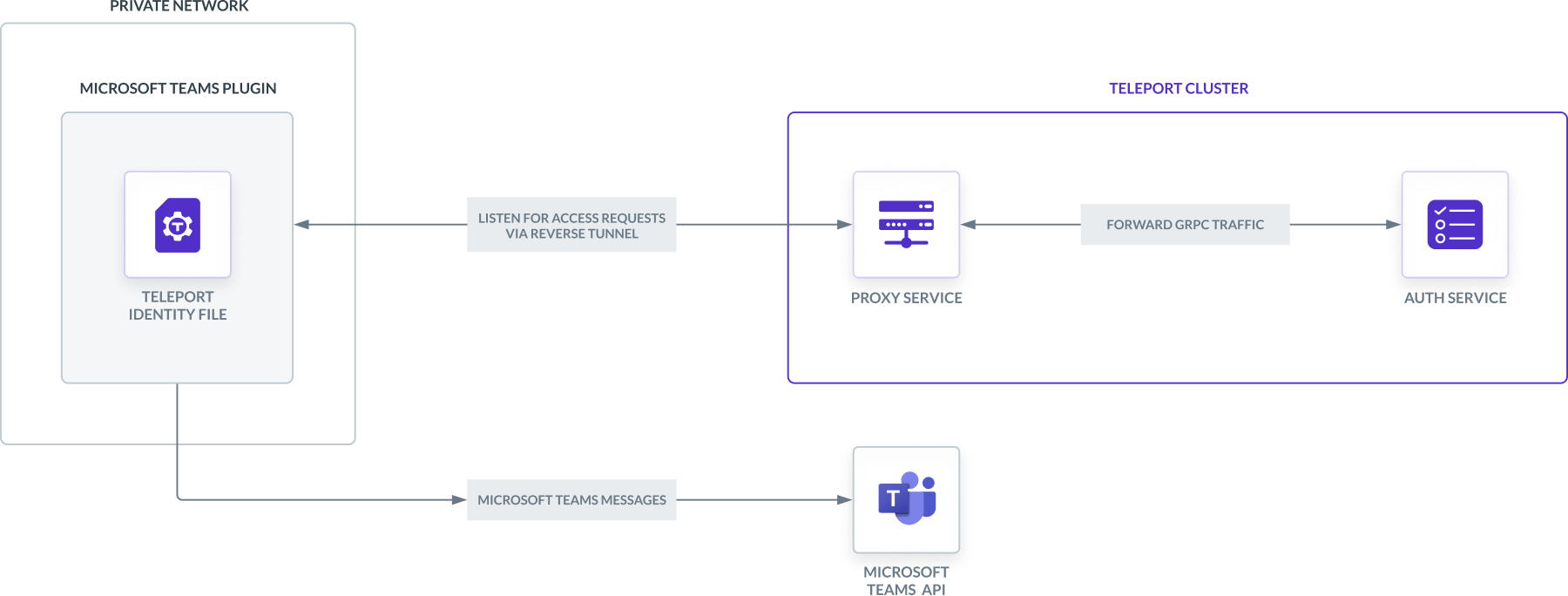
Prerequisites
- Self-Hosted Enterprise
- Teleport Enterprise Cloud
-
A running Teleport Enterprise cluster. For details on how to set this up, see the Enterprise Getting Started guide.
-
The Enterprise
tctladmin tool andtshclient tool version >= 14.3.33. You can download these tools by visiting your Teleport account. You can verify the tools you have installed by running the following commands:$ tctl version
# Teleport Enterprise v14.3.33 go1.21
$ tsh version
# Teleport v14.3.33 go1.21
-
A Teleport Enterprise Cloud account. If you do not have one, visit the signup page to begin a free trial of Teleport Team and upgrade to Teleport Enterprise Cloud.
-
The
tctladmin tool andtshclient tool version >= 16.4.3. To download these tools, visit the Installation page.$ tctl version
# Teleport Enterprise v16.4.3 go1.21
$ tsh version
# Teleport v16.4.3 go1.21
Recommended: Configure Machine ID to provide short-lived Teleport
credentials to the plugin. Before following this guide, follow a Machine ID
deployment guide
to run the tbot binary on your infrastructure.
- A Microsoft Teams License (Microsoft 365 Business).
- Azure console access in the organization/directory holding the Microsoft Teams License.
- An Azure resource group in the same directory. This will host resources for the the Microsoft Teams Access Request plugin. You should have enough permissions to create and edit Azure Bot Services in this resource group.
- Someone with Global Admin rights on the Azure Active Directory that will grant permissions to the plugin.
- Someone with the
Teams administratorrole that can approve installation requests for Microsoft Teams Apps. - Either an Azure virtual machine or Kubernetes cluster where you will run the Teleport Microsoft Teams plugin.
To check that you can connect to your Teleport cluster, sign in with tsh login, then
verify that you can run tctl commands using your current credentials.
tctl is supported on macOS and Linux machines.
For example:
$ tsh login --proxy=teleport.example.com [email protected]
$ tctl status
# Cluster teleport.example.com
# Version 14.3.33
# CA pin sha256:abdc1245efgh5678abdc1245efgh5678abdc1245efgh5678abdc1245efgh5678
If you can connect to the cluster and run the tctl status command, you can use your
current credentials to run subsequent tctl commands from your workstation.
If you host your own Teleport cluster, you can also run tctl commands on the computer that
hosts the Teleport Auth Service for full permissions.
Step 1/9. Define RBAC resources
Before you set up the Microsoft Teams plugin, you will need to enable Role Access Requests in your Teleport cluster.
For the purpose of this guide, we will define an editor-requester role, which
can request the built-in editor role, and an editor-reviewer role that can
review requests for the editor role.
Create a file called editor-request-rbac.yaml with the following content:
kind: role
version: v5
metadata:
name: editor-reviewer
spec:
allow:
review_requests:
roles: ['editor']
---
kind: role
version: v5
metadata:
name: editor-requester
spec:
allow:
request:
roles: ['editor']
thresholds:
- approve: 1
deny: 1
Create the roles you defined:
$ tctl create -f editor-request-rbac.yaml
role 'editor-reviewer' has been created
role 'editor-requester' has been created
Allow yourself to review requests by users with the editor-requester role by
assigning yourself the editor-reviewer role.
Assign the editor-reviewer role to your Teleport user by running the appropriate
commands for your authentication provider:
- Local User
- GitHub
- SAML
- OIDC
-
Retrieve your local user's configuration resource:
$ tctl get users/$(tsh status -f json | jq -r '.active.username') > out.yaml -
Edit
out.yaml, addingeditor-reviewerto the list of existing roles:roles:
- access
- auditor
- editor
+ - editor-reviewer -
Apply your changes:
$ tctl create -f out.yaml -
Sign out of the Teleport cluster and sign in again to assume the new role.
-
Retrieve your
githubauthentication connector:$ tctl get github/github --with-secrets > github.yamlNote that the
--with-secretsflag adds the value ofspec.signing_key_pair.private_keyto thegithub.yamlfile. Because this key contains a sensitive value, you should remove the github.yaml file immediately after updating the resource. -
Edit
github.yaml, addingeditor-reviewerto theteams_to_rolessection.The team you should map to this role depends on how you have designed your organization's role-based access controls (RBAC). However, the team must include your user account and should be the smallest team possible within your organization.
Here is an example:
teams_to_roles:
- organization: octocats
team: admins
roles:
- access
+ - editor-reviewer -
Apply your changes:
$ tctl create -f github.yaml -
Sign out of the Teleport cluster and sign in again to assume the new role.
-
Retrieve your
samlconfiguration resource:$ tctl get --with-secrets saml/mysaml > saml.yamlNote that the
--with-secretsflag adds the value ofspec.signing_key_pair.private_keyto thesaml.yamlfile. Because this key contains a sensitive value, you should remove the saml.yaml file immediately after updating the resource. -
Edit
saml.yaml, addingeditor-reviewerto theattributes_to_rolessection.The attribute you should map to this role depends on how you have designed your organization's role-based access controls (RBAC). However, the group must include your user account and should be the smallest group possible within your organization.
Here is an example:
attributes_to_roles:
- name: "groups"
value: "my-group"
roles:
- access
+ - editor-reviewer -
Apply your changes:
$ tctl create -f saml.yaml -
Sign out of the Teleport cluster and sign in again to assume the new role.
-
Retrieve your
oidcconfiguration resource:$ tctl get oidc/myoidc --with-secrets > oidc.yamlNote that the
--with-secretsflag adds the value ofspec.signing_key_pair.private_keyto theoidc.yamlfile. Because this key contains a sensitive value, you should remove the oidc.yaml file immediately after updating the resource. -
Edit
oidc.yaml, addingeditor-reviewerto theclaims_to_rolessection.The claim you should map to this role depends on how you have designed your organization's role-based access controls (RBAC). However, the group must include your user account and should be the smallest group possible within your organization.
Here is an example:
claims_to_roles:
- name: "groups"
value: "my-group"
roles:
- access
+ - editor-reviewer -
Apply your changes:
$ tctl create -f oidc.yaml -
Sign out of the Teleport cluster and sign in again to assume the new role.
Create a user called myuser who has the editor-requester role. This user
cannot edit your cluster configuration unless they request the editor role:
$ tctl users add myuser --roles=editor-requester
tctl will print an invitation URL to your terminal. Visit the URL and log in
as myuser for the first time, registering credentials as configured for your
Teleport cluster.
Later in this guide, you will have myuser request the editor role so you can
review the request using the Teleport plugin.
Step 2/9. Install the Teleport Microsoft Teams plugin
Install the Microsoft Teams plugin on your workstation. If you are deploying the plugin on Kubernetes, you will still need to install the plugin locally in order to generate an application archive to upload later in this guide.
- Download
- Docker Image
- From Source
- Helm Chart
We currently only provide linux-amd64 binaries. You can also compile these
plugins from source. You can run the plugin from a remote host or your local
development machine.
$ curl -L -O https://get.gravitational.com/teleport-access-msteams-v14.3.3-linux-amd64-bin.tar.gz
$ tar -xzf teleport-access-msteams-v14.3.3-linux-amd64-bin.tar.gz
$ cd teleport-access-msteams
$ sudo ./install
Make sure the binary is installed:
$ teleport-msteams version
teleport-msteams v14.3.3 git:teleport-msteams-v14.3.3-fffffffff go1.21
We currently only provide Docker images for linux-amd64.
Pull the Docker image for the latest access request plugin by running the following command:
$ docker pull public.ecr.aws/gravitational/teleport-plugin-msteams:14.3.3
Make sure the plugin is installed by running the following command:
$ docker run public.ecr.aws/gravitational/teleport-plugin-msteams:14.3.3 version
teleport-msteams v14.3.3 git:teleport-msteams-v14.3.3-api/14.0.0-gd1e081e 1.21
For a list of available tags, visit Amazon ECR Public Gallery.
To install from source you need git and go installed. If you do not have Go
installed, visit the Go downloads page.
$ git clone https://github.com/gravitational/teleport-plugins.git
$ cd teleport-plugins/access/msteams
$ make
Move the teleport-msteams binary into your PATH.
Make sure the binary is installed:
$ teleport-msteams version
teleport-msteams v14.3.3 git:teleport-msteams-v14.3.3-fffffffff go1.21
Allow Helm to install charts that are hosted in the Teleport Helm repository:
$ helm repo add teleport https://charts.releases.teleport.dev
Update the cache of charts from the remote repository:
$ helm repo update
Step 3/9. Create a user and role for the plugin
Teleport's Access Request plugins authenticate to your Teleport cluster as a user with permissions to list and read Access Requests. This way, plugins can retrieve Access Requests from the Teleport Auth Service and present them to reviewers.
Define a user and role called access-plugin by adding the following content to
a file called access-plugin.yaml:
kind: role
version: v5
metadata:
name: access-plugin
spec:
allow:
rules:
- resources: ['access_request']
verbs: ['list', 'read']
- resources: ['access_plugin_data']
verbs: ['update']
---
kind: user
metadata:
name: access-plugin
spec:
roles: ['access-plugin']
version: v2
Create the user and role:
$ tctl create -f access-plugin.yaml
As with all Teleport users, the Teleport Auth Service authenticates the
access-plugin user by issuing short-lived TLS credentials. In this case, we
will need to request the credentials manually by impersonating the
access-plugin role and user.
If you are running a self-hosted Teleport Enterprise deployment and are using
tctl from the Auth Service host, you will already have impersonation
privileges.
To grant your user impersonation privileges for access-plugin, define a role
called access-plugin-impersonator by pasting the following YAML document into
a file called access-plugin-impersonator.yaml:
kind: role
version: v5
metadata:
name: access-plugin-impersonator
spec:
allow:
impersonate:
roles:
- access-plugin
users:
- access-plugin
Create the access-plugin-impersonator role:
$ tctl create -f access-plugin-impersonator.yaml
If you are providing identity files to the plugin with Machine ID, assign the
access-plugin role to the Machine ID bot user. Otherwise, assign this role to
the user you plan to use to generate credentials for the access-plugin role
and user:
Assign the access-plugin-impersonator role to your Teleport user by running the appropriate
commands for your authentication provider:
- Local User
- GitHub
- SAML
- OIDC
-
Retrieve your local user's configuration resource:
$ tctl get users/$(tsh status -f json | jq -r '.active.username') > out.yaml -
Edit
out.yaml, addingaccess-plugin-impersonatorto the list of existing roles:roles:
- access
- auditor
- editor
+ - access-plugin-impersonator -
Apply your changes:
$ tctl create -f out.yaml -
Sign out of the Teleport cluster and sign in again to assume the new role.
-
Retrieve your
githubauthentication connector:$ tctl get github/github --with-secrets > github.yamlNote that the
--with-secretsflag adds the value ofspec.signing_key_pair.private_keyto thegithub.yamlfile. Because this key contains a sensitive value, you should remove the github.yaml file immediately after updating the resource. -
Edit
github.yaml, addingaccess-plugin-impersonatorto theteams_to_rolessection.The team you should map to this role depends on how you have designed your organization's role-based access controls (RBAC). However, the team must include your user account and should be the smallest team possible within your organization.
Here is an example:
teams_to_roles:
- organization: octocats
team: admins
roles:
- access
+ - access-plugin-impersonator -
Apply your changes:
$ tctl create -f github.yaml -
Sign out of the Teleport cluster and sign in again to assume the new role.
-
Retrieve your
samlconfiguration resource:$ tctl get --with-secrets saml/mysaml > saml.yamlNote that the
--with-secretsflag adds the value ofspec.signing_key_pair.private_keyto thesaml.yamlfile. Because this key contains a sensitive value, you should remove the saml.yaml file immediately after updating the resource. -
Edit
saml.yaml, addingaccess-plugin-impersonatorto theattributes_to_rolessection.The attribute you should map to this role depends on how you have designed your organization's role-based access controls (RBAC). However, the group must include your user account and should be the smallest group possible within your organization.
Here is an example:
attributes_to_roles:
- name: "groups"
value: "my-group"
roles:
- access
+ - access-plugin-impersonator -
Apply your changes:
$ tctl create -f saml.yaml -
Sign out of the Teleport cluster and sign in again to assume the new role.
-
Retrieve your
oidcconfiguration resource:$ tctl get oidc/myoidc --with-secrets > oidc.yamlNote that the
--with-secretsflag adds the value ofspec.signing_key_pair.private_keyto theoidc.yamlfile. Because this key contains a sensitive value, you should remove the oidc.yaml file immediately after updating the resource. -
Edit
oidc.yaml, addingaccess-plugin-impersonatorto theclaims_to_rolessection.The claim you should map to this role depends on how you have designed your organization's role-based access controls (RBAC). However, the group must include your user account and should be the smallest group possible within your organization.
Here is an example:
claims_to_roles:
- name: "groups"
value: "my-group"
roles:
- access
+ - access-plugin-impersonator -
Apply your changes:
$ tctl create -f oidc.yaml -
Sign out of the Teleport cluster and sign in again to assume the new role.
You will now be able to generate signed certificates for the access-plugin
role and user.
Step 4/9. Export the access plugin identity
Give the plugin access to a Teleport identity file. We recommend using Machine
ID for this in order to produce short-lived identity files that are less
dangerous if exfiltrated, though in demo deployments, you can generate
longer-lived identity files with tctl:
- Machine ID
- Long-lived identity files
Configure tbot with an output that will produce the credentials needed by
the plugin. As the plugin will be accessing the Teleport API, the correct
output type to use is identity.
For this guide, the directory destination will be used. This will write these
credentials to a specified directory on disk. Ensure that this directory can
be written to by the Linux user that tbot runs as, and that it can be read by
the Linux user that the plugin will run as.
Modify your tbot configuration to add an identity output.
If running tbot on a Linux server, use the directory output to write
identity files to the /opt/machine-id directory:
outputs:
- type: identity
destination:
type: directory
# For this guide, /opt/machine-id is used as the destination directory.
# You may wish to customize this. Multiple outputs cannot share the same
# destination.
path: /opt/machine-id
If running tbot on Kubernetes, write the identity file to Kubernetes secret
instead:
outputs:
- type: identity
destination:
type: kubernetes_secret
name: teleport-plugin-msteams-identity
If operating tbot as a background service, restart it. If running tbot in
one-shot mode, execute it now.
You should now see an identity file under /opt/machine-id or a Kubernetes
secret named teleport-plugin-msteams-identity. This contains the private key and signed
certificates needed by the plugin to authenticate with the Teleport Auth
Service.
Like all Teleport users, access-plugin needs signed credentials in order to
connect to your Teleport cluster. You will use the tctl auth sign command to
request these credentials.
The following tctl auth sign command impersonates the access-plugin user,
generates signed credentials, and writes an identity file to the local
directory:
$ tctl auth sign --user=access-plugin --out=identity
The plugin connects to the Teleport Auth Service's gRPC endpoint over TLS.
The identity file, identity, includes both TLS and SSH credentials. The
plugin uses the SSH credentials to connect to the Proxy Service, which
establishes a reverse tunnel connection to the Auth Service. The plugin
uses this reverse tunnel, along with your TLS credentials, to connect to the
Auth Service's gRPC endpoint.
Certificate Lifetime
By default, tctl auth sign produces certificates with a relatively short
lifetime. For production deployments, we suggest using Machine
ID to programmatically issue and renew
certificates for your plugin. See our Machine ID getting started
guide to learn more.
Note that you cannot issue certificates that are valid longer than your existing credentials.
For example, to issue certificates with a 1000-hour TTL, you must be logged in with a session that is
valid for at least 1000 hours. This means your user must have a role allowing
a max_session_ttl of at least 1000 hours (60000 minutes), and you must specify a --ttl
when logging in:
$ tsh login --proxy=teleport.example.com --ttl=60060
If you are running the plugin on a Linux server, create a data directory to hold certificate files for the plugin:
$ sudo mkdir -p /var/lib/teleport/api-credentials
$ sudo mv identity /var/lib/teleport/plugins/api-credentials
If you are running the plugin on Kubernetes, Create a Kubernetes secret that contains the Teleport identity file:
$ kubectl -n teleport create secret generic --from-file=identity teleport-plugin-msteams-identity
Once the Teleport credentials expire, you will need to renew them by running the
tctl auth sign command again.
Step 5/9. Register an Azure Bot
The Access Request plugin for Microsoft Teams receives Access Request events from the Teleport Auth Service, formats them into Microsoft Teams messages, and sends them to the Microsoft Teams API to post them in your workspace. For this to work, you must register a new Azure Bot. Azure Bot is a managed service by Microsoft that allows to develop bots that interact with users through different channels, including Microsoft Teams.
Register a new Azure bot
Visit https://portal.azure.com/#create/Microsoft.AzureBot to create a new bot. Choose the bot handle so you can find the bot later in the Azure console (the bot handle will not be displayed to the user or used to configure the Microsoft Teams plugin). Also edit the Azure subscription, the resource group and the bot pricing tier.
In the "Microsoft App ID" section choose "Single Tenant" and "Create new Microsoft App ID".
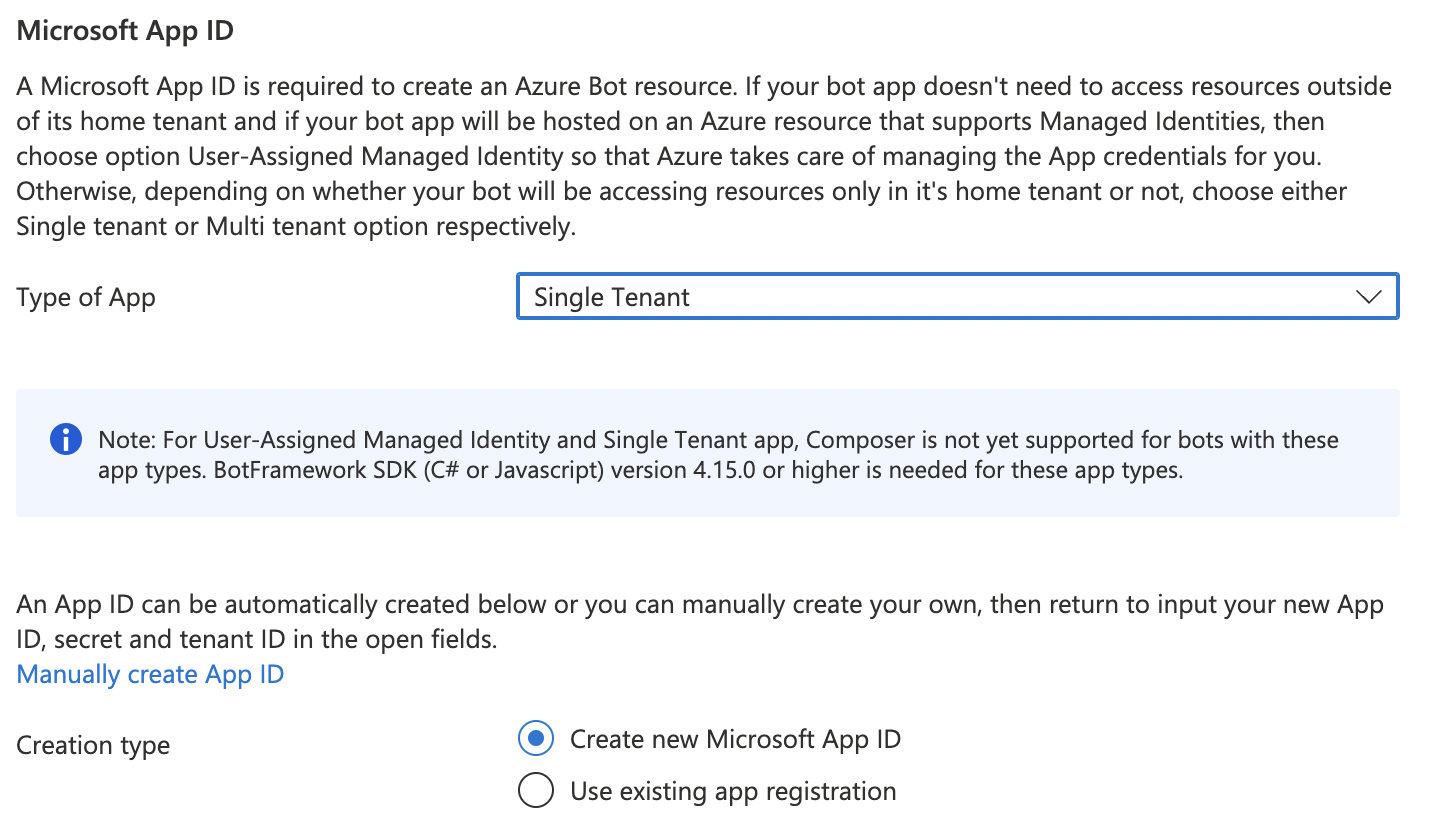
Connect the bot to Microsoft Teams
Once the bot is created, open its resource page on the Azure console and navigate to the "Channels" tab. Click "Microsoft Teams" and add the Microsoft Teams channel.
The result should be as follows:

Obtain information about your Microsoft App
On the bot's "Configuration" tab, copy and keep in a safe place the values of "Microsoft App ID" and "App Tenant ID". Those two UUIDs will be used in the plugin configuration.
Click the "Manage" link next to "Microsoft App ID". This will open the app management view.

Then, go to the "Certificates & Secrets" section and choose to create a "New client secret". Use the "Copy" icon to copy the newly created secret and keep it with the previously recovered App ID and Tenant ID.
The client secret will be used by the Teleport plugin to authenticate as the bot's app when searching users and posting messages.
Specify the permissions used by the app
Still in the app management view ("Configuration", then "Manage" the Microsoft App ID), go to the "API permissions" tab.
Add the following Microsoft Graph Application permissions:
| Permission name | Reason |
|---|---|
AppCatalog.Read.All | Used to list Teams Apps and check the app is installed. |
User.Read.All | Used to get notification recipients. |
TeamsAppInstallation.ReadWriteSelfForUser.All | Used to initiate communication with a user that never interacted with the Teams App before. |
TeamsAppInstallation.ReadWriteSelfForTeam.All | Used to discover if the app is installed in the Team. |
At this point the app declares the required permissions but those have not been granted.
If you are an admin, click "Grant admin consent for <directory name>". If you are not an admin, contact an admin user to grant the permissions.

Once permissions have been approved, refresh the page and check the approval status. The result should be as follows:

Step 6/9. Configure the Teleport Microsoft Teams plugin
At this point, the Teleport Microsoft Teams plugin has the credentials it needs to communicate with your Teleport cluster and Azure APIs, but the app has not been installed to Microsoft Teams yet.
In this step, you will configure the Microsoft Teams plugin to use the Azure credentials and generate the Teams App package that will be used to install the Microsoft Teams App. You will also configure the plugin to notify the right Microsoft Teams users when it receives an Access Request update.
Generate a configuration file and assets
Generate a configuration file for the plugin. The instructions depend on whether you are deploying the plugin on a virtual machine or Kubernetes:
- Virtual Machine
- Kubernetes
The Teleport Microsoft Teams plugin uses a config file in TOML format. The
configure subcommand generates the directory
/var/lib/teleport/plugins/msteams/assets containing the TOML configuration
file and an app.zip file that will be used later to add the Teams App into the
organization catalog.
Run the following command on your virtual machine:
$ export AZURE_APPID="your-appid"
$ export AZURE_TENANTID="your-tenantid"
$ export AZURE_APPSECRET="your-appsecret"
$ teleport-msteams configure /var/lib/teleport/plugins/msteams/assets --appID "$AZURE_APPID" --tenantID "$AZURE_TENANTID" --appSecret "$AZURE_APPSECRET"
This should result in a config file like the one below:
# Example Microsoft Teams plugin configuration TOML file
# If true, channels and users existence is checked on plugin start. When a
# user is checked, the app is installed for the user if it was not
# already. Installation can take up to 10 seconds per user. It is
# advised to enable preloading unless you are sure all users already got
# the app installed to avoid possible timeouts when treating an access request.
preload = true
[teleport]
# Teleport Auth/Proxy Server address.
# addr = "example.com:3025"
#
# Should be port 3025 for Auth Server and 3080 or 443 for Proxy.
# For Teleport Cloud, should be in the form "your-account.teleport.sh:443".
# Credentials generated with `tctl auth sign`.
#
# When using --format=file:
# identity = "/var/lib/teleport/plugins/msteams/identity" # Identity file
# refresh_identity = true # Refresh identity file periodically
#
# When using --format=tls:
# client_key = "/var/lib/teleport/plugins/msteams/auth.key" # Teleport TLS secret key
# client_crt = "/var/lib/teleport/plugins/msteams/auth.crt" # Teleport TLS certificate
# root_cas = "/var/lib/teleport/plugins/msteams/auth.cas" # Teleport CA certs
addr = "localhost:3025"
identity = "identity"
refresh_identity = true
[msapi]
# MS API IDs. Please, check the documentation.
app_id = "xxxxxxxx-xxxx-xxxx-xxxx-xxxxxxxxxxxx"
# Either contains the app secret or the path of a file containing the secret
app_secret = "XXXXXXXXXXXXXXXXXXXXXX"
tenant_id = "xxxxxxxx-xxxx-xxxx-xxxx-xxxxxxxxxxxx"
teams_app_id = "xxxxxxxx-xxxx-xxxx-xxxx-xxxxxxxxxxxx"
[role_to_recipients]
# Map roles to recipients.
#
# Provide msteams user email/id or channel URL recipients for access requests for specific roles.
# role.suggested_reviewers will automatically be treated as additional email recipients.
# "*" must be provided to match non-specified roles.
#
# "dev" = "devs-msteams-channel"
# "*" = ["[email protected]", "admin-msteams-channel"]
"*" = ["[email protected]"]
[log]
output = "stderr" # Logger output. Could be "stdout", "stderr" or "/var/lib/teleport/msteams.log"
severity = "INFO" # Logger severity. Could be "INFO", "ERROR", "DEBUG" or "WARN".
Copy the /var/lib/teleport/plugins/msteams/assets/app.zip file to your local
computer. You will have to upload it to Microsoft Teams later.
On the host where you will run the Microsoft Teams plugin, move the file
/var/lib/teleport/plugins/msteams/assets/teleport-msteams.toml to
/etc/teleport-msteams.toml. You can then edit the copy located in /etc/.
Run the following command on your local machine:
$ export AZURE_APPID="your-appid"
$ export AZURE_TENANTID="your-tenantid"
$ export AZURE_APPSECRET="your-appsecret"
$ teleport-msteams configure /var/lib/teleport/plugins/msteams/assets --appID "$AZURE_APPID" --tenantID "$AZURE_TENANTID" --appSecret "$AZURE_APPSECRET"
This command generates an application archive at
/var/lib/teleport/plugins/msteams/assets/app.zip. You will upload it to
Microsoft Teams later in this guide.
Create a file on your workstation called teleport-msteams-helm.yaml with the
following content:
# Default values for slack.
# This is a YAML-formatted file.
# Declare variables to be passed into your templates.
#
# Plugin specific options
#
teleport:
address: "teleport.example.com:443"
identitySecretName: teleport-plugin-msteams-identity
identitySecretPath: identity
msTeams:
appID: "APP_ID"
tenantID: "TENANT_ID"
teamsAppID: "TEAMS_APP_ID"
roleToRecipients:
"*": "TELEPORT_USERNAME"
"editor": "TELEPORT_USERNAME"
log:
output: stdout
severity: INFO
You will edit this file in the next section.
The configure command is not idempotent. It generates a new Microsoft Teams
application UUID with each execution. It is not possible to use an app.zip and
a TOML configuration generated by two different executions.
Edit the configuration file
Edit the configuration file according to the instructions below.
[teleport]
The Microsoft Teams plugin uses this section to connect to your Teleport cluster.
- Executable or Docker
- Helm Chart
addr: Include the hostname and HTTPS port of your Teleport Proxy Service
or Teleport Enterprise Cloud tenant (e.g., teleport.example.com:443 or
mytenant.teleport.sh:443).
identity: Fill this in with the path to the identity file you exported
earlier.
client_key, client_crt, root_cas: Comment these out, since we
are not using them in this configuration.
address: Include the hostname and HTTPS port of your Teleport Proxy Service
or Teleport Enterprise Cloud tenant (e.g., teleport.example.com:443 or
mytenant.teleport.sh:443).
identitySecretName: Fill in the identitySecretName field with the name
of the Kubernetes secret you created earlier.
identitySecretPath: Fill in the identitySecretPath field with the path
of the identity file within the Kubernetes secret. If you have followed the
instructions above, this will be identity.
If you are providing credentials to the plugin using a tbot binary that runs
on a Linux server, make sure the value of identity is the same as the path of
the identity file you configured tbot to generate, /opt/machine-id/identity.
Configure the plugin to periodically reload the identity file, ensuring that it does not attempt to connect to the Teleport Auth Service with expired credentials.
Add the following to the teleport section of the configuration:
refresh_identity = true
[msapi]/msTeams
- Executable or Docker
- Helm Chart
Make sure the app_id, app_secret, tenant_id, and teams_app_id fields are
filled in with the correct information, which you obtained earlier in this
guide.
Make sure the appID, tenantID, and teamsAppID fields are filled in with
the correct information, which you obtained earlier in this guide.
[role_to_recipients]
The role_to_recipients map (roleToRecipients for Helm users) configures the
users and channels that the Microsoft Teams plugin will notify when a user
requests access to a specific role. When the Microsoft Teams plugin receives an
Access Request from the Auth Service, it will look up the role being requested
and identify the Microsoft Teams users and channels to notify.
- Executable or Docker
- Helm Chart
Here is an example of a role_to_recipients map. Each value can be a single
string or an array of strings:
[role_to_recipients]
"*" = "[email protected]"
"dev" = ["[email protected]", "[email protected]"]
"dba" = "https://teams.microsoft.com/l/channel/19%3somerandomid%40thread.tacv2/ChannelName?groupId=xxxxxxxx-xxxx-xxxx-xxxx-xxxxxxxxxxxx&tenantId=xxxxxxxx-xxxx-xxxx-xxxx-xxxxxxxxxxxx"
In the Helm chart, the role_to_recipients field is called roleToRecipients
and uses the following format, where keys are strings and values are arrays of
strings:
roleToRecipients:
"*": "[email protected]"
"dev": ["[email protected]", "[email protected]"]
"dba": "https://teams.microsoft.com/l/channel/19%3somerandomid%40thread.tacv2/ChannelName?groupId=xxxxxxxx-xxxx-xxxx-xxxx-xxxxxxxxxxxx&tenantId=xxxxxxxx-xxxx-xxxx-xxxx-xxxxxxxxxxxx"
In the role_to_recipients map, each key is the name of a Teleport role. Each
value configures the Teams user (or users) to notify. Each string must be either
the email address of a Microsoft Teams user or a channel URL.
You can find the URL of a channel by opening the channel and clicking the button "Get link to channel":
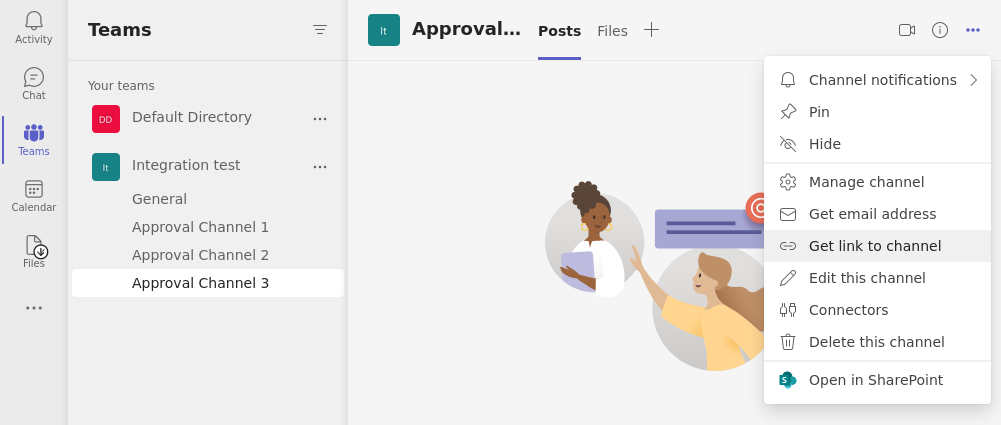
The role_to_recipients map must also include an entry for "*", which the
plugin looks up if no other entry matches a given role name. In the example
above, requests for roles aside from dev and dba will notify [email protected].
Suggested reviewers
Users can suggest reviewers when they create an Access Request, e.g.,:
$ tsh request create --roles=dbadmin [email protected],[email protected]
If an Access Request includes suggested reviewers, the Microsoft Teams plugin will add these to the list of channels to notify. If a suggested reviewer is an email address, the plugin will look up the the direct message channel for that address and post a message in that channel.
Configure the Microsoft Teams plugin to notify you when a user requests the editor role
by adding the following to your role_to_recipients config (replace
TELEPORT_USERNAME with the email of the user you assigned the editor-reviewer
role earlier):
- Executable or Docker
- Helm Chart
[role_to_recipients]
"*" = "TELEPORT_USERNAME"
"editor" = "TELEPORT_USERNAME"
roleToRecipients:
"*": "TELEPORT_USERNAME"
"editor": "TELEPORT_USERNAME"
The final configuration file should resemble the following:
- Executable or Docker
- Helm Chart
# Example Microsoft Teams plugin configuration TOML file
# If true, channels and users existence is checked on plugin start. When a
# user is checked, the app is installed for the user if it was not
# already. Installation can take up to 10 seconds per user. It is
# advised to enable preloading unless you are sure all users already got
# the app installed to avoid possible timeouts when treating an access request.
preload = true
[teleport]
# Teleport Auth/Proxy Server address.
# addr = "example.com:3025"
#
# Should be port 3025 for Auth Server and 3080 or 443 for Proxy.
# For Teleport Cloud, should be in the form "your-account.teleport.sh:443".
# Credentials generated with `tctl auth sign`.
#
# When using --format=file:
# identity = "/var/lib/teleport/plugins/msteams/identity" # Identity file
# refresh_identity = true # Refresh identity file periodically
#
# When using --format=tls:
# client_key = "/var/lib/teleport/plugins/msteams/auth.key" # Teleport TLS secret key
# client_crt = "/var/lib/teleport/plugins/msteams/auth.crt" # Teleport TLS certificate
# root_cas = "/var/lib/teleport/plugins/msteams/auth.cas" # Teleport CA certs
addr = "localhost:3025"
identity = "identity"
refresh_identity = true
[msapi]
# MS API IDs. Please, check the documentation.
app_id = "xxxxxxxx-xxxx-xxxx-xxxx-xxxxxxxxxxxx"
# Either contains the app secret or the path of a file containing the secret
app_secret = "XXXXXXXXXXXXXXXXXXXXXX"
tenant_id = "xxxxxxxx-xxxx-xxxx-xxxx-xxxxxxxxxxxx"
teams_app_id = "xxxxxxxx-xxxx-xxxx-xxxx-xxxxxxxxxxxx"
[role_to_recipients]
# Map roles to recipients.
#
# Provide msteams user email/id or channel URL recipients for access requests for specific roles.
# role.suggested_reviewers will automatically be treated as additional email recipients.
# "*" must be provided to match non-specified roles.
#
# "dev" = "devs-msteams-channel"
# "*" = ["[email protected]", "admin-msteams-channel"]
"*" = ["[email protected]"]
[log]
output = "stderr" # Logger output. Could be "stdout", "stderr" or "/var/lib/teleport/msteams.log"
severity = "INFO" # Logger severity. Could be "INFO", "ERROR", "DEBUG" or "WARN".
# Default values for slack.
# This is a YAML-formatted file.
# Declare variables to be passed into your templates.
#
# Plugin specific options
#
teleport:
address: "teleport.example.com:443"
identitySecretName: teleport-plugin-msteams-identity
identitySecretPath: identity
msTeams:
appID: "APP_ID"
tenantID: "TENANT_ID"
teamsAppID: "TEAMS_APP_ID"
roleToRecipients:
"*": "TELEPORT_USERNAME"
"editor": "TELEPORT_USERNAME"
log:
output: stdout
severity: INFO
Step 7/9. Add and configure the Teams App
Upload the Teams App
Open Microsoft Teams and go to "Apps", "Manage your apps", then in the additional choices menu choose "Upload an App".
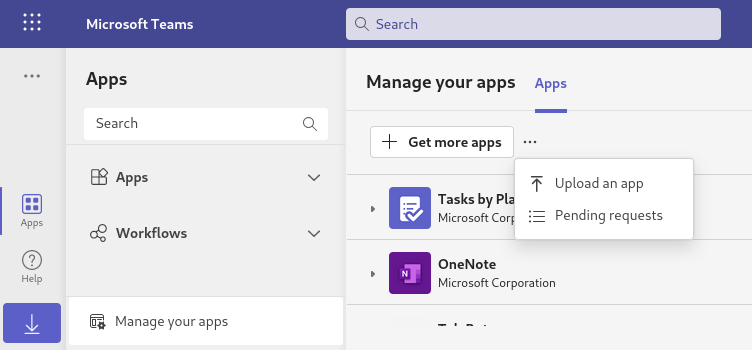
If you're a Teams admin, choose "Upload an app to your org's app catalog". This will allow you to skip the approval step. If you're not a Microsoft Teams admin, choose "Submit an app to your org".
Upload the app.zip file you generated earlier.
Approve the Teams App
If you are not a Teams admin and chose "Submit an app to your org", you will have to ask a Teams admin to approve it.
They can do so by connecting to the Teams admin dashboard, searching "TeleBot", selecting it and choosing "Allow".

Add the Teams App to a Team
Once the app is approved it should appear in the "Apps built for your org" section. Add the newly uploaded app to a team. Open the app, click "Add to a team", choose the "General" channel of your team and click "Set up a bot".
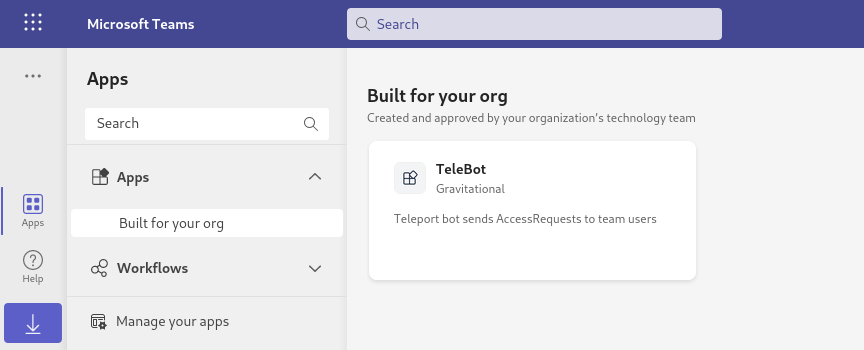
Note: Once an app is added to a team, it can post on all channels.
Step 8/9. Test the Teams App
Once Teleport is running, you've created the Teams App, and the plugin is configured, you can now run the plugin and test the workflow.
Test Microsoft Teams connectivity
Start the plugin in validation mode:
$ teleport-msteams validate <email of your teams account>
If everything works fine, the log output should look like this:
teleport-msteams v14.3.3 go1.21
- Checking application xxxxxxxx-xxxx-xxxx-xxxx-xxxxxxxxxxxx status...
- Application found in the team app store (internal ID: xxxxxxxx-xxxx-xxxx-xxxx-xxxxxxxxxxxx)
- User [email protected] found: xxxxxxxx-xxxx-xxxx-xxxx-xxxxxxxxxxxx
- Application installation ID for user: XXXXXXXXXXXXXXXXXXXXXXXXXXXXXXXXXXXXXXXXXXXXXXXXXXXXXXXXXXXXXXXXXXXXXXXXXXXXXXXXXXXXXXXXXXXXXXXXXXXX
- Chat ID for user: 19:xxxxxxxx-xxxx-xxxx-xxxx-xxxxxxxxxxxx_xxxxxxxx-xxxx-xxxx-xxxx-xxxxxxxxxxxx@unq.gbl.spaces
- Chat web URL: https://teams.microsoft.com/l/chat/19%3Axxxxxxxx-xxxx-xxxx-xxxx-xxxxxxxxxxxx_xxxxxxxx-xxxx-xxxx-xxxx-xxxxxxxxxxxx%40unq.gbl.spaces/0?tenantId=xxxxxxxx-xxxx-xxxx-xxxx-xxxxxxxxxxxx
- Hailing the user...
- Message sent, ID: XXXXXXXXXXXXX
Check your MS Teams!
The plugin should exit and you should have received two messages through Microsoft Teams.

Start the MS Teams Plugin
After you configured and validated the MS Teams plugin, you can now run the plugin and test the workflow.
- Executable
- Docker
- Helm Chart
Run the following command to start the Teleport MS Teams plugin. The -d flag
will provide debug information to ensure that the plugin can connect to MS Teams
and your Teleport cluster:
$ teleport-msteams start -d
DEBU DEBUG logging enabled msteams/main.go:120
INFO Starting Teleport MS Teams Plugin 14.3.3: msteams/app.go:74
DEBU Attempting GET teleport.example.com:443/webapi/find webclient/webclient.go:129
DEBU Checking Teleport server version msteams/app.go:242
INFO MS Teams app found in org app store id:292e2881-38ab-7777-8aa7-cefed1404a63 name:TeleBot msteams/app.go:179
INFO Preloading recipient data... msteams/app.go:185
INFO Recipient found, chat found chat_id:19:a8c06deb-aa2b-4db5-9c78-96e48f625aef_a36aec2e-f11c-4219-b79a-19UUUU57de70@unq.gbl.spaces kind:user recipient:[email protected] msteams/app.go:195
INFO Recipient data preloaded and cached. msteams/app.go:198
DEBU Watcher connected watcherjob/watcherjob.go:121
INFO Plugin is ready msteams/app.go:227
Run the plugin:
$ docker run -v <path-to-config>:/etc/teleport-msteams.toml public.ecr.aws/gravitational/teleport-plugin-msteams:14.3.33 start
Install the plugin:
$ helm upgrade --install teleport-plugin-msteams teleport/teleport-plugin-msteams --values teleport-msteams-helm.yaml
To inspect the plugin's logs, use the following command:
$ kubectl logs deploy/teleport-plugin-msteams
Debug logs can be enabled by setting log.severity to DEBUG in
teleport-msteams-helm.yaml and executing the helm upgrade ... command
above again. Then you can restart the plugin with the following command:
$ kubectl rollout restart deployment teleport-plugin-msteams
Create an Access Request
Create an Access Request and check if the plugin works as expected with the following steps.
- As an Admin
- As a User
- From the Web UI
A Teleport admin can create an Access Request for another user with tctl:
$ tctl request create myuser --roles=editor
Users can use tsh to create an Access Request and log in with approved roles:
$ tsh request create --roles=editor
Seeking request approval... (id: 8f77d2d1-2bbf-4031-a300-58926237a807)
Users can request access using the Web UI by visiting the "Access Requests" tab and clicking "New Request":
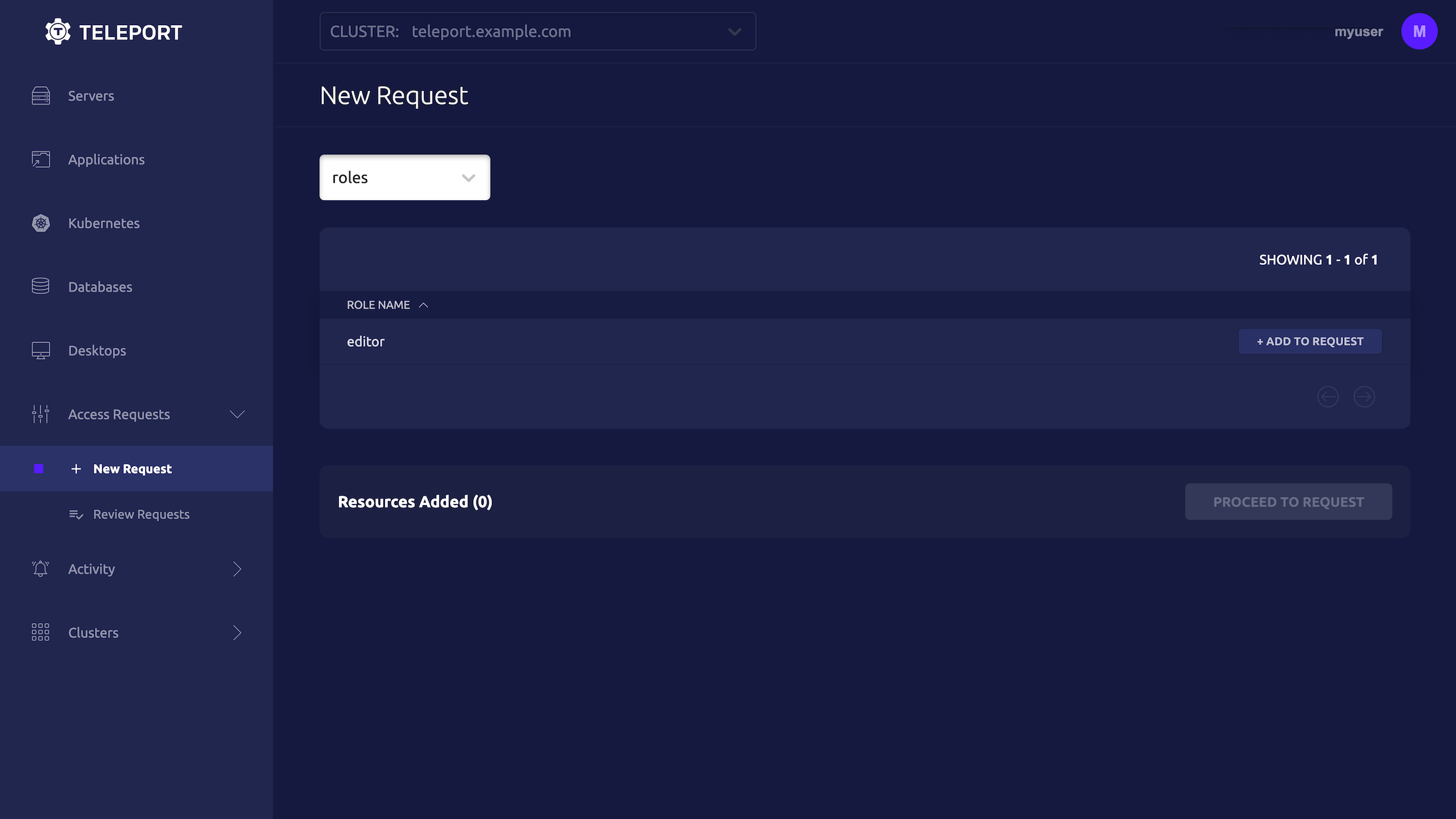
The user you configured earlier to review the request should receive a direct message from "TeleBot" in Microsoft Teams allowing them to visit a link in the Teleport Web UI and either approve or deny the request.
Resolve the request
Once you receive an Access Request message, click the link to visit Teleport and approve or deny the request:

Reviewing from the command line
You can also review an Access Request from the command line:
- As an Admin
- As a User
# Replace REQUEST_ID with the id of the request
$ tctl request approve REQUEST_ID
$ tctl request deny REQUEST_ID
# Replace REQUEST_ID with the id of the request
$ tsh request review --approve REQUEST_ID
$ tsh request review --deny REQUEST_ID
Once the request is resolved, the Microsoft Teams bot will update the Access Request message to reflect its new status.
When the Microsoft Teams plugin posts an Access Request notification to a channel, anyone with access to the channel can view the notification and follow the link. While users must be authorized via their Teleport roles to review Access Requests, you should still check the Teleport audit log to ensure that the right users are reviewing the right requests.
When auditing Access Request reviews, check for events with the type Access Request Reviewed in the Teleport Web UI.
Step 9/9. Set up systemd
This section is only relevant if you are running the Teleport Microsoft Teams plugin on a virtual machine.
In production, we recommend starting the Teleport plugin daemon via an init system like systemd. Here's the recommended Teleport plugin service unit file for systemd:
[Unit]
Description=Teleport MsTeams Plugin
After=network.target
[Service]
Type=simple
Restart=on-failure
ExecStart=/usr/local/bin/teleport-msteams start --config=/etc/teleport-msteams.toml
ExecReload=/bin/kill -HUP $MAINPID
PIDFile=/run/teleport-msteams.pid
[Install]
WantedBy=multi-user.target
Save this as teleport-msteams.service in either /usr/lib/systemd/system/ or
another unit file load
path
supported by systemd.
Enable and start the plugin:
$ sudo systemctl enable teleport-msteams
$ sudo systemctl start teleport-msteams
Next steps
- Read our guides to configuring Resource Access Requests and Role Access Requests so you can get the most out of your Access Request plugins.